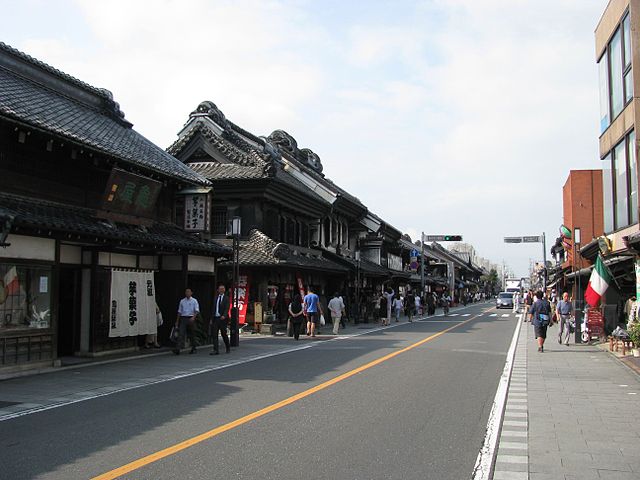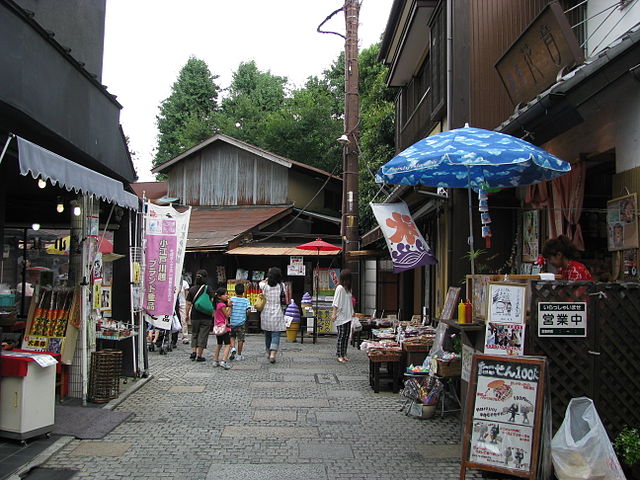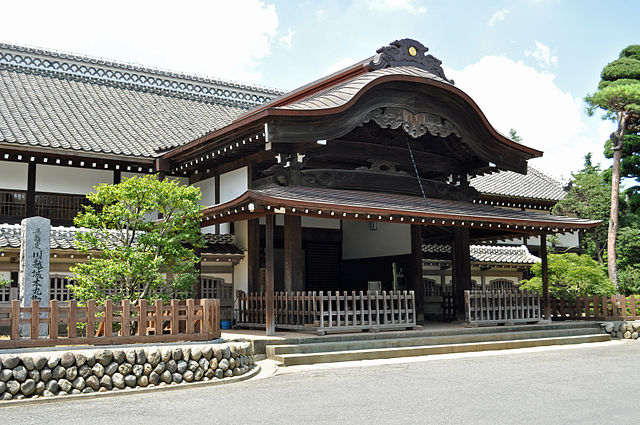|
Kawagoe is an old trading outpost of the ancient capital Edo. It is located about 30 minutes by train from central Tokyo and is suitable as a day trip destination.
During the Edo Period "1603-1867", Kawagoe was an important city to Tokyo for trade and strategic purposes. Close ties were formed between the two cities and over the years Kawagoe gained many aspects of Edo culture and architecture. The presence of the strong Edo period atmospheres have earned the city the nickname of Little Edo "Koedo", after the old name for Tokyo. |
|
It's easy to slip down a small side road away from the crowds to soak in the peace and get a feel of what Japan was once like.
Following an event known as the Kawagoe Great Fire in 1893, wealthy traders supplying resources to the old Edo capital began to reconstruct their warehouse in the Kurazukuri style “traditional Japanese storehouses”. While very costly to build, this method of construction, which - while still looking distinctively Japanese - is made from fire-resistant materials, rather than the wood traditionally used. |
|
The buildings are crowned with steep tile roofs featuring immense, fire-deflecting Onigawara "Ogre tiles". Some of the buildings managed to survive to this day, in an area known as Warehouse District "Kurazukuri no Machinami", full of clay-walled warehouse buildings.
Mostly housing shops and restaurants, they can be found along the main Kurazukuri Street which stretches a few hundred meters long, about 1.5 kilometers north of Kawagoe Station. While narrow sidewalks along a fairly trafficked road takes away some of the charm, it is still a worthwhile excursion from Tokyo, for those interested in catching a fleeting glance of the elusive "old Japan". |
|
The Kawagoe Kurazukuri Museum is located along the main street.
The museum is housed in a traditional warehouse which used to be a tobacco wholesaler's shop built in 1893. Visitors can walk around inside and experience the life of Edo merchants. The artisan shops in the area include Machikan, a sword and knife manufacturer in operation for generations. |
|
Just a short distance from the main street stands the Bell Tower "Toki no Kane", a landmark and symbol of Kawagoe. The present structure goes back to 1894, a year after the Great Fire of Kawagoe.
The tower is three stories tall, 16 meters in height, and its beautiful chimes currently ring out four times a day: 6:00, 12:00, 15:00 and 18:00. The Bell Tower is just that - there's nowhere to go inside or buy souvenirs, although you can walk underneath it to access the tiny but beautiful Yakushi Shrine on the other side. |
|
A minute's walk away is the Candy Alley "Kashiya Yokocho", a small backstreet alley where a dozen stores sell old-fashioned traditional Japanese sweets, including those made from sweet potato, one of the well-known products of Kawagoe.
The location was known as a neighborhood where scores of confectionery manufactures lined the alley. Many tourists come here to enjoy the nostalgic atmosphere of the early Showa period. It is a wonderful place for trying some traditional Japanese sweets, while experiencing an ambiance of past decades. |
|
Every year on the third Saturday and Sunday of October it's time for the exciting Kawagoe Matsuri "Kawagoe Festival". It's one of the most exciting festivals in the Kanto region and maintains a history of more than 360 years.
It is the festival of the nearby Hikawa Shrine and involves the parading of tall, elaborately decorated Dashi "floats", through the streets of the city center. The highlight of the festival starts after sunset when lots of lanterns on the floats are lit. |
|
With lots of excited musicians and dancers on top of the floats, people start to pull them along the streets again.
When a float overtakes another, they face each other, the music gets louder, and they get into a kind of competition. This is called "Hikkawase" and it feels like a battle of music, cheered by excited spectators. As usual there’s a lots of entertainment and food stalls around. There are temporary sidewalk restaurants severing from Yakisoba to Barbecue to sweets, and many kinds of beverages. |
|
Honmaru Goten "Kawagoe Castle" used to serve as the lord's residence and offices. It was originally built in 1457, but unfortunately the castle was dismantlement in the 1870's.
Today only the Primary Hall "Honmaru Goten" and the Yagura "Tower", are the only surviving structures of the former Kawagoe Castle. Recently it was renovated and reopened to the public consisting of a spacious tatami rooms, a garden, and pictures of cultural heritage which are put on display. Honmaru Goten is a ten minutes’ walk from the Warehouse District. |
|
Kawagoe City Museum's permanent exhibition focuses on modern times and the recent past.
There is a life-size street of kurazukuri merchant houses which reveals the various unique layers involved in its construction. Other models include a geographical representation of the former castle town, illustrating how Kawagoe took shape over the centuries. The Kawagoe City Art Museum is located just next to the City Museum, with a collection of local art. Honmaru Goten "Kawagoe Castle", is located just across the street. |
|
Kawagoe's Kitain is the head temple of the Tendai Sect in the Kanto Region. Kitain is originally part of a three-temple complex built in 830, the other two being the Naka-in which is now a separate temple "can be reached in a 5 minutes’ walk", and Minami-in that remains only a cemetery.
Kitain temple is notable for its main hall, part of the original Edo Castle in downtown Tokyo, which was moved here by the Shogun to rebuild the temple after a fire. These are today the only surviving buildings of Edo Castle because of the damage Tokyo suffered during the Great Kanto Earthquake of 1923 and World War II. |
|
Another highlight of a visit to Kitain is the Gohyaku Rakan Statues, 540 stone statues of the disciples of Buddha, each with its own facial expression.
Kita-in is also noted for Semba Tosho-gu Shrine, enshrining the spirit of Tokugawa Ieyasu. Semba Tosho-gu Shrine is one of the three most important Toshogu shrines in Japan. The other two are in Nikko and Shizuoka. Kitain Temple is a 15 minutes’ walk from Hon-Kawagoe Station or the Warehouse District, and about 20 minutes from Kawagoe Station. |
Kawagoe AccessFrom Tokyo the fastest route is the Tobu Tojo Line from Ikebukuro Station, which takes 30 minutes on the express to reach Kawagoe Station.
Kawagoe Station and Shinjuku Station are also connected by direct trains via Omiya Station, along the JR Saikyo Line "54 minutes". This trip is covered by the Japan Rail Pass. |
|
Hon-Kawagoe Station is closer to the temple and Warehouse districts. From Seibu-Shinjuku Station take Seibu-Shinjuku Line to Hon-Kawagoe Station “50-60 minutes”.
Crea Mall "an outdoor shopping mall", is a 2-minutes’ walk from Kawagoe Station and stretches to the front of Hon Kawagoe Station. It is filled with what one would expect of any modern shopping center: major chain retailers, smaller privately-owned specialty shops, huge Atre and Maruhiro department stores, and plenty of places to eat and drink. |
|
Toyoko Line is linked to the Tokyo Metro Fukutoshin Line subway, allowing trains to continue north to Shinjuku Station, Ikebukuro Station and into Saitama prefecture.
You can take a direct train from Yokohama Station to Kawagoe Station "90-110 minutes". Coming from Tokyo on Tobu Tojo Line, next to Kawagoe Station is Kawagoe-shi Station. Kawagoe Line is connecting Kawagoe Station to Saitama City’s Omiya Station "22 minutes". |
Kawagoe Muslim Friendly AccommodationHere as you see, the closest Muslim friendly hotels in the area can be found in Tokyo. Once you click on any of the hotels, you will be redirected to an online booking website where you can make your reservation.
There are more Muslim friendly hotels in Tokyo listed on our website. For booking random hotels you can search with Hotels.com. There are Vacation Rentals in the area which suit travelers who prefer to rent a living space, especially for larger groups, families or those who seek a more local, everyday life experience. If you are traveling light and looking for a more economical place to stay Hostels and Guesthouses are good options. For booking a rental car use the search engine below. Fill out the details; pickup and drop-off places, date and time, and press search. You will be redirected to Rental Cars website where a list of available cars will be shown to you to choose from. |
|
|
|
Kawagoe-shi - Saitama Prefecture





















